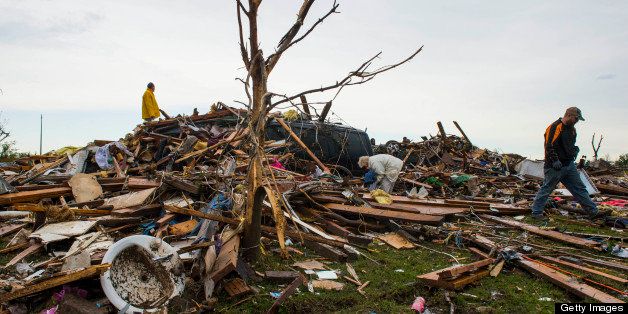
My weekly Skype session with my family in Morocco came to an abrupt end at the sound of the first emergency sirens in Oklahoma City on Sunday, May 19. I immediately grabbed what in my mind are irreplaceable items: my laptop computer with all my work, my passport, my permanent residency card and headed towards the nearest "safe" place in the lower level of the parking garage at the university. Having lived in Oklahoma for 11 years, I knew full well that one cardinal rule here is never to take chances with Mother Nature.
The memories of the 1999 and 2003 tornadoes were perhaps too distant, and there was an air of complacency in heeding the sudden orders to shelter. Even on Sunday, a day before the deadly tornado in Moore, many didn't take the sirens too seriously. The few students that gathered in the lower level of the parking garage at the university were lackadaisical about the threat of a tornado. After all, this is early summer in Oklahoma, it is tornado season, and this is common occurrence in this part of the state known as a tornado alley. Sirens tolled twice, but the threat was deemed to be too far off Oklahoma City that we reemerged from our hideout unscathed, and perhaps too complacent.
Then on the next day on that fateful day Monday, May 20, the sirens sounded off once again around 2:30 p.m. in Oklahoma City. This time many university employees and students headed towards shelter, and waited for news of the exact location of the tornado. However, the erratic nature of the tornado path makes it almost impossible to detect its trajectory with a great deal of accuracy. The people of Moore didn't have but 16-20 minutes to react to the sirens, and face what is arguably the biggest tornado in recent history. Chances for no human casualties were slim. Gathered in the faculty-in-residence apartment in one of the university's residence halls, a few students, staff and I watched the local TV coverage of the twister as it slowly built momentum and turned from a mild storm to a giant two-mile monster tornado that wreaked havoc leaving a path of destruction in its trail. The devastation is horrific and so far dwarfs that of the 1999 Moore tornado that killed 47 people.
Moore, the Oklahoma City metropolitan area, indeed the whole state of Oklahoma is collectively mobilizing to help those affected by the deadly tornado. Acts of generosity and volunteerism are awe-inspiring. Calls for better tornado preparedness and readiness are heard, especially in public schools and hospitals. Tragedies such as this have a binding effect on any community, and the Oklahoma community is showing its mettle as search and rescue continues in Moore. Amidst the pile of rubble and metal scrap, Moore and Oklahoma will reemerge from this natural disaster stronger and closer as a community. If there is anything I have learned about Oklahomans, it is their toughness in the face of adversity. Whether it is the dust bowl of the 1930s or the terrorist bombing of the federal building in 1995, the community has managed to reemerge even stronger and more resilient. After all, as one Moore survivor defiantly stated: "We are going to be fine. We are Okies and that's what we are known for."
